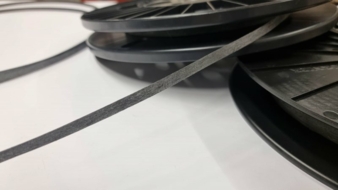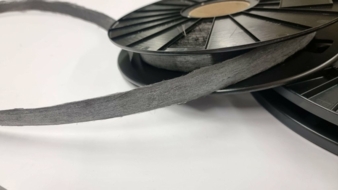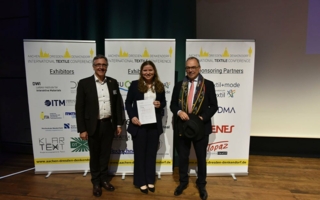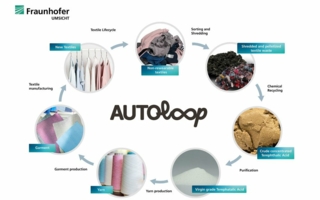08/01/2025 – Lightweight construction — auf Deutsch lesen
Tapes made from recycled carbon fibers
The DITF have developed highly oriented tapes made from recycled carbon fibers (rCF) suitable for reuse in high-performance applications such as structural components in the automotive sector.
Due to their excellent mechanical properties and low weight, carbon fibre reinforced plastics (CFRP) are increasingly being used in lightweight construction applications where high strength and rigidity combined with minimal weight are crucial. However, the growing use of CFRP is also accompanied by large quantities of carbon fibre waste. Currently, only 15% of CFRP waste is recycled. The remaining 85% of these CFRP components end up in waste incineration plants or landfills at the end of their service life. Incineration can generate energy in the form of heat or electricity. However, recycling carbon fibres would contribute far more to climate and resource protection.
Making carbon fibre-based composite recyclable
So far, only processing routes that significantly reduce the properties of CFRP and thus limit the fields of application have been established. The German Institutes of Textile and Fiber Research Denkendorf (DITF) have been successfully working for around 15 years on adapting classic spinning processes to the new fibre material rCF. The aim is to develop a new category of rCF semi-finished products and improve their mechanical properties so that they can actually replace virgin fibre material in structural applications. Only then will carbon fibre-based composite materials be truly recyclable.
In order to produce an oriented semi-finished product similar to a carbon product from virgin fibres, it is crucial to eliminate the tangled position of the rCF and to align the fibres parallel to each other. One promising way of achieving this is the production of highly oriented tapes.
In a first step, the carbon fibres are opened and mixed with thermoplastic matrix fibres (polyamide 6). The fibre mixture is then further separated and oriented in a carding process modified for the processing of carbon fibres. At the outlet of the carding machine, the fibre card web produced in the carding process is combined into a fibre sliver and deposited in a can. This rCF/PA6 fibre sliver is the starting material for the subsequent tape forming process and already has a pre-orientation of the carbon fibres. The orientation of the fibres can be increased in the subsequent drawing process. By drawing the fibre tape, the fibres are moved in the direction of draft and aligned longitudinally. The final process step is tape formation, in which the fibre tape is under tension formed into the desired shape and then fixed into a continuous tape structure. During fixation, the thermoplastic fibres melt partially or completely and then solidify.
Recycling instead of downcycling
This technology developed at the DITF for the production of highly oriented rCF tapes was used as part of the “Infinity” research project (03LB3006) to demonstrate a sustainable and fibre-friendly recycling cycle for CFRP. Based on the “Infinity” tapes, a composite material was developed that achieved 88% of the tensile strength and tensile modulus of a comparable virgin fibre product. In addition, a life cycle analysis showed that the global warming potential is reduced by approx. 49% when using pyrolysis fibres and by approx. 66% for rCF from production waste.
The findings thus illustrate a way towards true substitution of virgin fibre CFRP with recycled CFRP instead of downcycling to low-orientation materials and the associated loss of mechanical properties.





